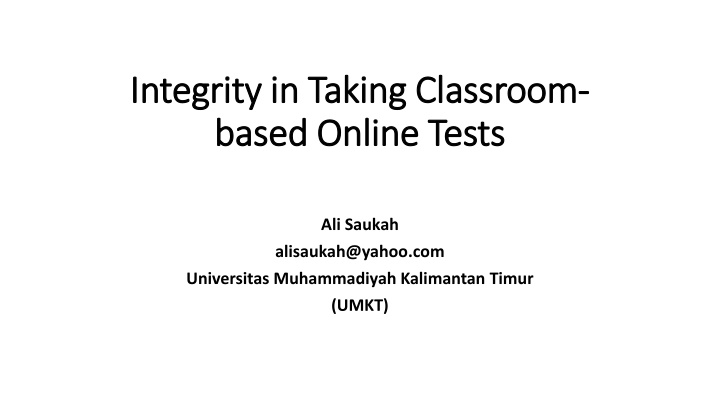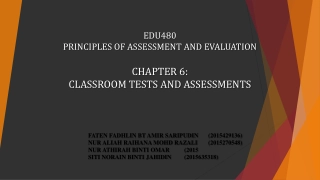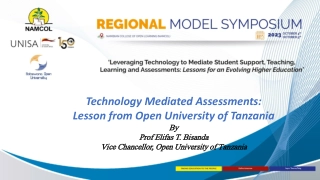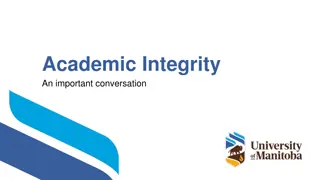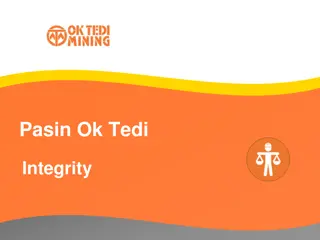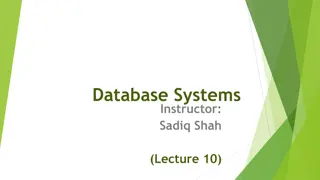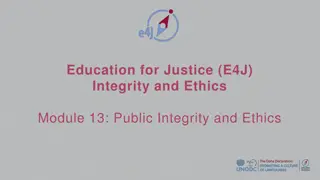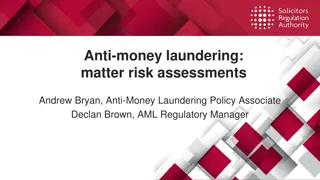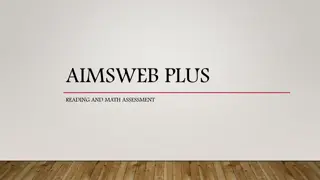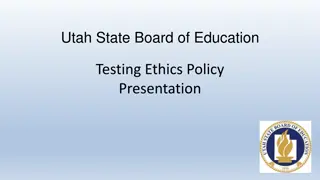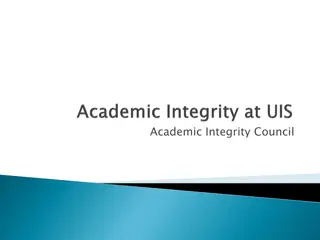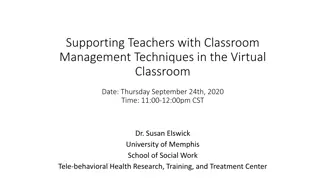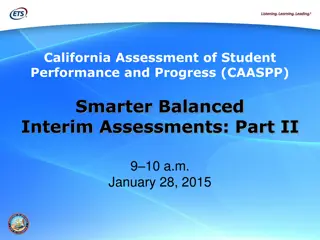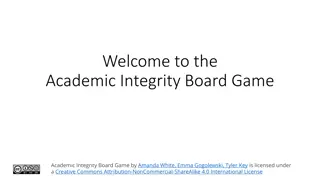Enhancing Classroom Integrity Through Online Assessments
Developing classroom-based online assessments can minimize cheating potential and ensure test reliability. Implementing strategies like using multiple choice questions with strategic options and time limits can help teachers conduct fair tests online. This approach facilitates synchronous online testing with minimal chances for cheating, enhancing learning efficiency while maintaining test security.
Download Presentation

Please find below an Image/Link to download the presentation.
The content on the website is provided AS IS for your information and personal use only. It may not be sold, licensed, or shared on other websites without obtaining consent from the author.If you encounter any issues during the download, it is possible that the publisher has removed the file from their server.
You are allowed to download the files provided on this website for personal or commercial use, subject to the condition that they are used lawfully. All files are the property of their respective owners.
The content on the website is provided AS IS for your information and personal use only. It may not be sold, licensed, or shared on other websites without obtaining consent from the author.
E N D
Presentation Transcript
Integrity in Taking Classroom Integrity in Taking Classroom- - based Online Tests based Online Tests Ali Saukah alisaukah@yahoo.com Universitas Muhammadiyah Kalimantan Timur (UMKT)
Increasing Integrity in Taking Online Tests by Developing Classroom-Based Online Assessment is reducing the potentials for cheating. Lack of integrity in taking a test will affect the reliability and validity of the test negatively. Ideally, reducing the potentials for cheating into minimum, online assessment should be done like the Computer-based National Exam (UNBK) or internet-based TOEFL (iBT TOEFL) which is operationally supervised (proctored) in testing centers offline. It requires a lot of human resources, time, energy, and funds to develop the system.
What about the development of classroom-based Online Assessment? Is it possible to have classroom-based online assessment which can reduce the potentials for cheating into a minimum? How can a teacher teaching 4 parallel classes give an achievement (fair-) test (not a formative test) to all the students in the class once synchronously online without involving a video- conference, and with minimal potentials for cheating? How can a teacher develop classroom-based assessment for learning efficiently? easy to construct, easy to score, and yet, hard for non-competent students to answer with minimal potentials for cheating.
The experience I would like to share here is based on the assessment of learning of a content course measuring the cognitive aspect. It may need a lot of adjustment and creativity if it is applied to the productive aspects of the skills courses and the non- cognitive aspects of the content courses. Convert the original questions of a test to multiple choice consisting of 4 options, 2 substantial options ("Both options (a) and (b) are right" and "Both options (a) and (b) are wrong"), and 2 strategic options. These strategic options (c and d) must be used both as the keys and the distractors. Limit the time based on a try-out done by the instructor so that competent students will have sufficient time to finish the test, and non-competent students will not have sufficient time to cheat.
The test is administered online synchronously by providing the students with the link to the Google Form, with a specified time schedule and duration, for example from 12.35 till 13.00 (25 minutes for 25 items). Some minutes before the time schedule, the link is given to the students organized in WAG so they can start doing the test on time and finish before the time limit. Their answers will not be recorded until they click "submit". Students must be told about this. The order of the test items is randomized so that every student may have a different version of the test with the same content and key answers.
Or to minimize the potential for cheating, each page in the Google Form contains only one item, and in the last page, they will find Submit menu to click after they finish doing the test, before the Google Form is closed. Every student must write their email address in the Google Form for them to get their scores right after the test. The instructor will get the list of students and their scores right after the test, with some statistical analysis. Different instructors teaching the same course can collaborate to construct the same test, administered at the same time.
We cannot prevent students from taking pictures, screenshot, opening notes, getting answers from others, but we can convince them that it will not affect their performance in the test because: they really need time to think about the correct answers. and time to do the test is limited We can also warn them that cheating is a serious crime. The inclusion of the strategic options will make it harder for the unprepared test-takers to choose the correct answers. Therefore, they will waste their time if they do not concentrate on doing the test.
If our test is curriculum bound, other than students taking the course will not be able to answer the questions, except the experts. Therefore, it is very unlikely that anybody else will be able to help the students to do the test at home. The following is INSTRUCTIONS TO PREPARE FOR TAKING a TEST based on my own experience developing and administering the midterm test of my course on Research Statistics taken by 121 students spread in 4 different classes in different time schedules. Therefore, to administer the midterm test, the same schedule for the midterm test must be set and agreed by all students in all the four classes.
INSTRUCTIONS TO PREPARE FOR TAKING a TEST like the following must be shared with all the students several days before the time scheduled for the test: I will administer the test on Wednesday Oct 21, 2020, from 12.35 to 13.00 (25 Multiple Choice items in 25 minutes only). No more time for the students to fill in the form/test answers after 13.00 sharp. The Google Form will be closed automatically. Every student will get the link to the midterm test one hour before the time from WAG of each class. So, make sure their attendance list has been confirmed in the list of students' names one hour before the test schedule, in WAG of each class. Every student can use any gadget or laptop to open the Google Form from the link in the WAG of each class. Work independently. Don't even think of cheating by looking at notes or ask anybody. Nobody is allowed to take pictures or screenshot of any part of the test. Cheaters will FAIL the test/course. You must feel guilty because you are guilty if you violate the golden rule of honesty in testing. Make sure you click "Submit" at the end of the test before the TIME LIMIT (before 13.00). Your answers will not be recorded/kept without clicking "Submit". Without clicking "Submit" you will not be considered having taken the test. You must start at 12.35 sharp right after Google Form can be opened. Make sure your email is valid and correctly typed in the form. You will know your scores after taking the test from your email. Good luck!
The result is wonderful! There was only one person complaining about the internet connection problem which I could handle very easily by setting another schedule one hour after the previous schedule. It was done smoothly. Nobody else complains about the test administration and about the score reports which they receive immediately in their own emails. The result of the item analysis automatically done by the machine indicates that the test is moderate in terms of the difficulty level with the mean approximately indicating a normal distribution.
Questionnaires after the Semester about the Students Integrity Reports: Did you have any intention to cheat during the test? Answers: 50% Yes 50% No Did you eventually cheat in the test? Answers: 71% No 29% Yes Any Comments?
Concluding Remarks 1) The root of the problems related to the integrity of the test takers needs to be identified and the solutions need to be developed to solve the problems. To help improve the validity of the decisions about the students achievement, more authentic assessments integrated in the classroom activities should be utilized. Classroom-based online testing system should be developed to reduce the tendency for the students to cheat in the test. 2) 3)
